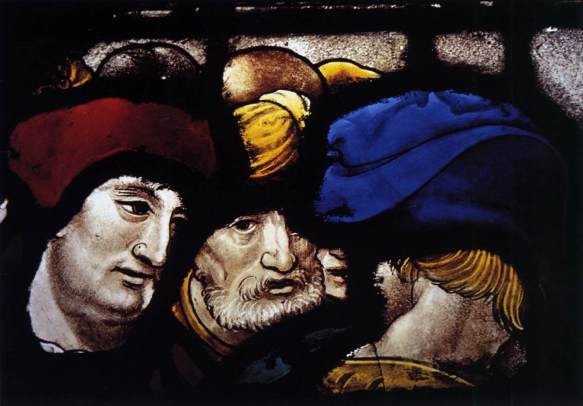During the Italian Renaissance, artworks done during the Middle Ages were considered barbaric. The artist’s emphasis on during the Gothic era on religious symbolism was replaced by a new emphasis on three-dimensional perspective. The formerly divided sections of glass with lead beams became camouflaged as window sections appeared connected. Technological advancements permitted utilization of diamond blades and thinner glass; and, preference was for clear glass(“white”) which permitted better light for viewing the Italian wall frescoes.
Circa 1550, were painted directly on to clear glass — rather in a way that oil colors are applied to a canvas — and then fired. This meant that the clear glass could be of regular shapes. Leading became purely utilitarian and no longer served the artistic purpose of accentuating the painted lines.
At the beginning of the 16th century the spirit which had inspired English stained glass artists for the past 300 years seems to have withered, and this decline was accelerated by two important events: the employment of foreign artists, mostly Germans or Flemings, to carry out large scale commissions … and later, the effect of the Reformation which officially brought the making of religious stained glass windows to an end.
In any case they were no longer typically English, nor were they characteristically stained glass windows, the glass being merely used as a transparent canvas on which the scene or figures were painted. The influence of the Italian Renaissance had finally conquered the art of stained glass.
The figures came nearer to human proportions and displayed a much greater knowledge of anatomy. The features were strongly drawn and modelled with a heavy stippled shading, as were the rich draperies which clothed the figures. The canopies had lost their silvery look, were rather more coarse in style, and the architectural features often showed a mixture of Gothic and Classical detail. The latter were often decorated with typical Renaissance features such as naked cupids. festoons of foliage, or grotesque heads drawn in matt and stain on white [clear] glass.
Backgrounds of landscape or interiors treated in perspective replaced the older grounds of red or blue glass. Buildings, trees, perhaps with birds flying through clouded skies, would help to add realism to the landscape, while paneled walls, tiled floors, and even furniture would be shown in the interiors, in an attempt to create the illusion of depth.
These windows are to be judged against the great mural paintings of the time rather than the traditional art of stained glass.
Heraldry was still one of the most popular subjects for filling windows, especially after the Reformation, and it was in this type of decoration only that the high standard of medieval technique was maintained in the post-Reformation period.
The Reformation, with its revolutionary change in religious opinion, prevented the making of religious windows, and until the end of the century glass painters concentrated upon the production of heraldic or secular windows. These often consisted of roundels set against plain glazed backgrounds. The subjects depicted were sometimes religious and used for private devotion; at other times they consisted of classically inspired scenes or merely scrolls with inscriptions in black-letter type.
Cardinal Guillaume Briçonnet financed the reconstruction and decoration of the church Saint-Saturnin in Tours The stained glass windows illustrated scenes from the lives of St Catherine and the Apostle Thomas. Dismantled during the Revolution, the windows were later partly reinstalled in Notre-Dame-la-Riche.
Stained glass was widely used in secular context during the Renaissance in France, providing another way of introducing colour into interior decoration. Such windows long featured roundels in their centres – circular, oval, and even square compartments intended to maximize the light.
This window is one of a series from the gallery at Écouen that combines ciphers, devices, and emblems of Anne de Montmorency with strapwork, triumphal caps, and grotesques.
This window is devoted in its entirety to Solomon the king whose wish was to obtain the wisdom necessary to deliver justice. It depicts several episodes from the king’s life, from infancy to old age. The variety of its colours, its meticulous rendering of costume, and its impressive architectural backgrounds combine to make this stained glass window one of the true masterpieces of the early Parisian Renaissance.
In 1586-88, the vestry of Saint-Étienne-du-Mont commissioned several times Nicolas Pinaigrier, who ran one of the largest stained glass workshops in Paris, for the execution of stained glass windows. Pinaigrier complied by delivering windows depicting four Saints, the Resurrection, the Incredulity of St Thomas, and the Holy Women at the Tomb. Pinaigrier did not stain glass but painted on it, a technique that offered a large range of graphic and chromatic effects.
The stained glass windows in the church Saint-Gervais-Saint-Protais at Gisors represents six scenes from the life of the Virgin. They are executed in grisaille, silver yellow and scarlet against a white ground. These windows exemplify the technical advances and stylistic evolution of the medium of stained glass under the influence of the school of Fontainebleau.
This picture represents the Visitation scene.
The stained glass windows in the church Saint-Gervais-Saint-Protais at Gisors represents six scenes from the life of the Virgin. They are executed in grisaille, silver yellow and scarlet against a white ground. These windows exemplify the technical advances and stylistic evolution of the medium of stained glass under the influence of the school of Fontainebleau.
This picture represents Zachariah from the Visitation scene. His face and posture derive from Raphael tapestry cartoons, probably by way of an engraver in his circle.
The stained glass windows in the church Saint-Gervais-Saint-Protais at Gisors represents six scenes from the life of the Virgin. They are executed in grisaille, silver yellow and scarlet against a white ground. These windows exemplify the technical advances and stylistic evolution of the medium of stained glass under the influence of the school of Fontainebleau.
This picture represents the Annunciation scene.
This stained glass window, originally in the choir of the Sainte-Chapelle at Vincennes, depicts François I wearing the mantel and collar of the Order of Saint-Michel, kneeling on a violet cushion before a damask-draped prieu-dieu bearing an open book. This portrait, despite the accuracy of the likeness, does not date from the king’s lifetime. The stained glass window was executed by the Parisian glazier Nicolas Beaurain between 1551 and 1556.
This fragment of a stained glass window comes from the Sainte-Chapelle of the royal palace of Vincennes. Other elements are held in the Musée National de la Renaissance, Écouen. The stained glass window was executed by the Parisian glazier Nicolas Beaurain after the design of Claude Bauduin. Beaurain also worked for the châteaux of Fontainebleau and Anet.
The stained-glass artist had to compose his window from the sheets of glass he received from the glass-house. The painted panels were assembled into a window using strips of lead. Because of the shape and size of the pieces of glass at the artist’s disposal, the outlines of the figures did not coincide with the leads. The figure of St Catherine, shown in the picture has a heavy outline of lead strips, but the individual panels are rather irregular, their shapes bearing little relationship to that of the saint. As a result, the leads cut across the figure her and there, rather than following the shapes.
Crash










